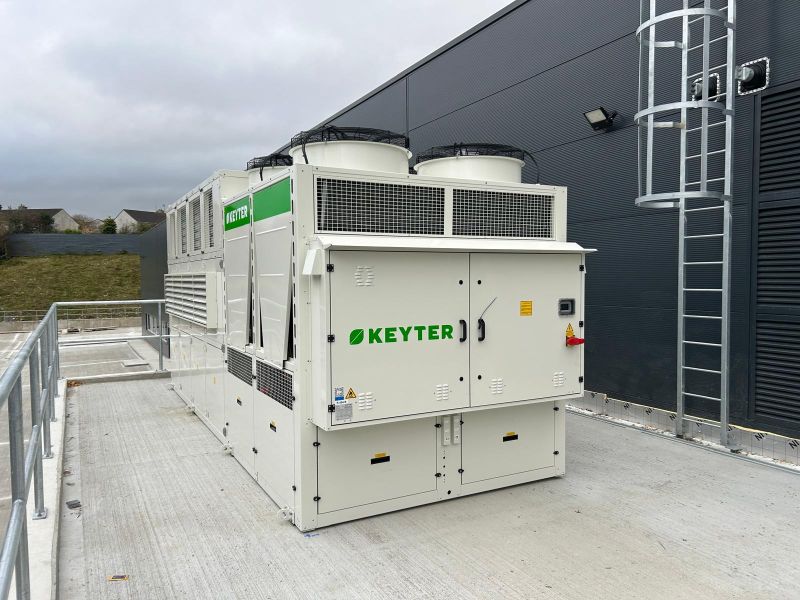EER and COP: The difference every HVAC professional should know
In the drive toward industrial decarbonization and efficient HVAC, heat pumps stand out as a key technology. However, to unlock their full potential, it’s essential to understand how their performance is measured accurately.
To assess their effectiveness, two key metrics are used: EER (Energy Efficiency Ratio) and COP (Coefficient of Performance).
Although both measure efficiency, their application and the conditions under which they are calculated are different and not interchangeable.

In this technical article, we will analyze these two concepts in detail, their calculation methods under European standards, and their practical meaning for equipment selection.
1. EER (Energy Efficiency Ratio): Efficiency in Cooling Mode
The EER is the indicator that measures a heat pump’s efficiency when operating in cooling mode. It represents the ratio between the cooling capacity the unit can deliver and the electrical energy it consumes to achieve it at a specific moment. It is, therefore, an “instantaneous” or “snapshot” value of performance.
The formula for its calculation is as follows:
EER = Delivered Cooling Capacity (kW) / Electrical Power Input (kW)
To make this value comparable across different units and manufacturers, its measurement is standardized under the European standard EN 14511. This standard specifies very strict test conditions:
- Indoor conditions: 27 °C dry-bulb temperature and 50% relative humidity.
- Outdoor conditions: 35 °C dry-bulb temperature.
It’s crucial to understand why relative humidity is a determining factor indoors but not outdoors. In cooling mode, the indoor unit acts as the evaporator, and its performance is directly affected by the humidity of the return air. By contrast, the outdoor unit operates as the condenser, whose performance does not depend on ambient humidity.
An EER of 3.25, for example, means that for every 1 kWh of final electrical energy consumed from the grid, the heat pump delivers 3.25 kWh of useful cooling energy.
2. COP (Coefficient of Performance): Efficiency in Heating Mode
Analogous to EER, COP measures the unit’s efficiency—only in this case, in heating mode. It defines the ratio between the heating output the heat pump delivers and the electrical energy it consumes to do so, also under specific, standardized conditions.
The formula is conceptually identical:
COP = Delivered Heating Capacity (kW) / Electrical Power Input (kW)
According to EN 14511, the test conditions for heating mode differ from those for cooling:
- Indoor conditions: 20 °C dry-bulb temperature.
- Outdoor conditions: 7 °C dry-bulb temperature and 6 °C wet-bulb temperature.
In this mode, the roles of the units are reversed. The indoor unit acts as the condenser, so the relative humidity of the indoor air does not affect its performance. By contrast, the outdoor unit becomes the evaporator, and its ability to extract heat from the outdoor air does depend on humidity and temperature; hence both conditions (dry-bulb and wet-bulb) are specified.
A COP of 3.21 indicates that for every 1 kWh of final electrical energy consumed, the unit can deliver 3.21 kWh of useful heating energy to the conditioned space.
The Fundamental Role of the EN 14511 Standard
The importance of EN 14511 (and its transposition in Spain as UNE-EN 14511) cannot be overstated. This standard ensures that EER and COP measurements are performed in a laboratory under controlled, repeatable conditions, with the equipment operated for a defined period. This guarantees that the values declared by manufacturers are reliable and comparable, enabling engineers and technicians to make informed decisions based on consistent data.
It’s important to note that both EER and COP always refer to final energy consumption—that is, the electrical energy measured directly at the unit’s electrical panel.
Conclusion
In summary, EER and COP are the pillars for evaluating a heat pump’s instantaneous performance. EER applies exclusively to cooling mode, while COP is used for heating mode. Both indicators demonstrate these systems’ ability to multiply the energy they consume, delivering more thermal energy (cooling or heating) than the electrical energy they require.
Understanding their differences—and the strict standards that govern their calculation—is essential for any HVAC professional aiming not just to comply, but to optimize the energy efficiency of their projects. These values are the starting point for more advanced analyses, such as seasonal efficiencies (SEER and SCOP), which evaluate the unit’s behavior over an entire operating season.
More articles
Interested in other (technical) knowledge articles? Keep yourself up to date and read them all

